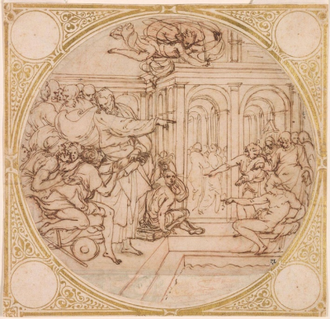Gospel in Art: Christ Healing the Lame at the Pool of Bethesda

Christ Healing the Lame at the Pool of Bethesda by Perino del Vaga, 1539 © Morgan Library, New York
Source: Christian Art
Gospel of 1 April 2025
John 5:1-3, 5-16
There was a feast of the Jews, and Jesus went up to Jerusalem.
Now there is in Jerusalem by the Sheep Gate a pool, in Aramaic called Bethesda, which has five roofed colonnades. In these lay a multitude of the sick - blind, lame, and paralysed. One man was there who had been sick for thirty-eight years. When Jesus saw him lying there and knew that he had already been there a long time, he said to him, 'Do you want to be healed?' The sick man answered him, 'Sir, I have no one to put me into the pool when the water is stirred up, and, while I am going, another steps down before me.' Jesus said to him, 'Get up, take up your bed, and walk.' And at once the man was healed, and he took up his bed and walked.
Now that day was the Sabbath. So the Jews said to the man who had been healed, 'It is the Sabbath, and it is not lawful for you to take up your bed.' But he answered them, 'The man who healed me, that man said to me, "Take up your bed, and walk."' They asked him, 'Who is the man who said to you, "Take up your bed and walk"?' Now the man who had been healed did not know who it was, for Jesus had withdrawn, as there was a crowd in the place.
Afterwards Jesus found him in the Temple and said to him, 'See, you are well! Sin no more, that nothing worse may happen to you.' The man went away and told the Jews that it was Jesus who had healed him. And this was why the Jews were persecuting Jesus, because he was doing these things on the Sabbath.
Reflection on the old Master Drawing
Our drawing by Perino del Vaga from 1538 captures the moment when Christ encourages the lame man to rise, assuring him that he is healed. Beneath the man, we see his rolled-up mat, a key detail in the Gospel account, which tells us that he will now pick up his mat and walk away. At the top of the drawing, an angel hovers, said to be the one who stirred the healing waters of the pool. As the Gospel recounts, the blind, lame, and paralysed gathered there, waiting for the waters to move in hope of being restored. Born in Florence, Perino del Vaga later moved to Rome, where he joined Raphael's workshop. Alongside Giulio Romano, he emerged as one of the most significant artists from the master's circle. It is a beautiful drawing, capturing a dynamic rendering of today's Gospel story.
Jesus' question to the lame man might seem somewhat strange: 'Do you want to be well again?' The man had been coming to the pool for thirty-eight years. Surely it was obvious that he wanted to be healed? Yet Jesus still asks. Of course, he already knew what was in the man's heart, but he wanted the man to reflect on his own desires and acknowledge his need for healing. We have to want to be healed! This invites us to consider: what is the healing that we truly seek? Healing from addictions, healing from impatience, healing from grumpiness,...?
There is another unusual element in this Gospel passage. When Jesus asks the man if he wants to be healed, he does not respond with a simple 'Yes, I want to be well'. Instead, he complains about his situation, explaining that he has no one to help him into the pool. His response is understandable, yet striking. Then, after being healed, we do not hear of him leaping with joy or praising Jesus. He simply picks up his mat and walks away. Perhaps he was not the most grateful of people, or perhaps he simply struggled to process what had happened. It may seem ungenerous to criticise him, but his response certainly invites reflection, particularly during Lent. Are we truly grateful for all we have received? Do we recognise and acknowledge all the blessings given to us? Or have we simply walked away, taking everything for granted?
LINKS
Gospel in Art: https://christian.art/
Today's Reflection: https://christian.art/daily-gospel-reading/john-5-1-3-5-16-2025/ (with audio)


















